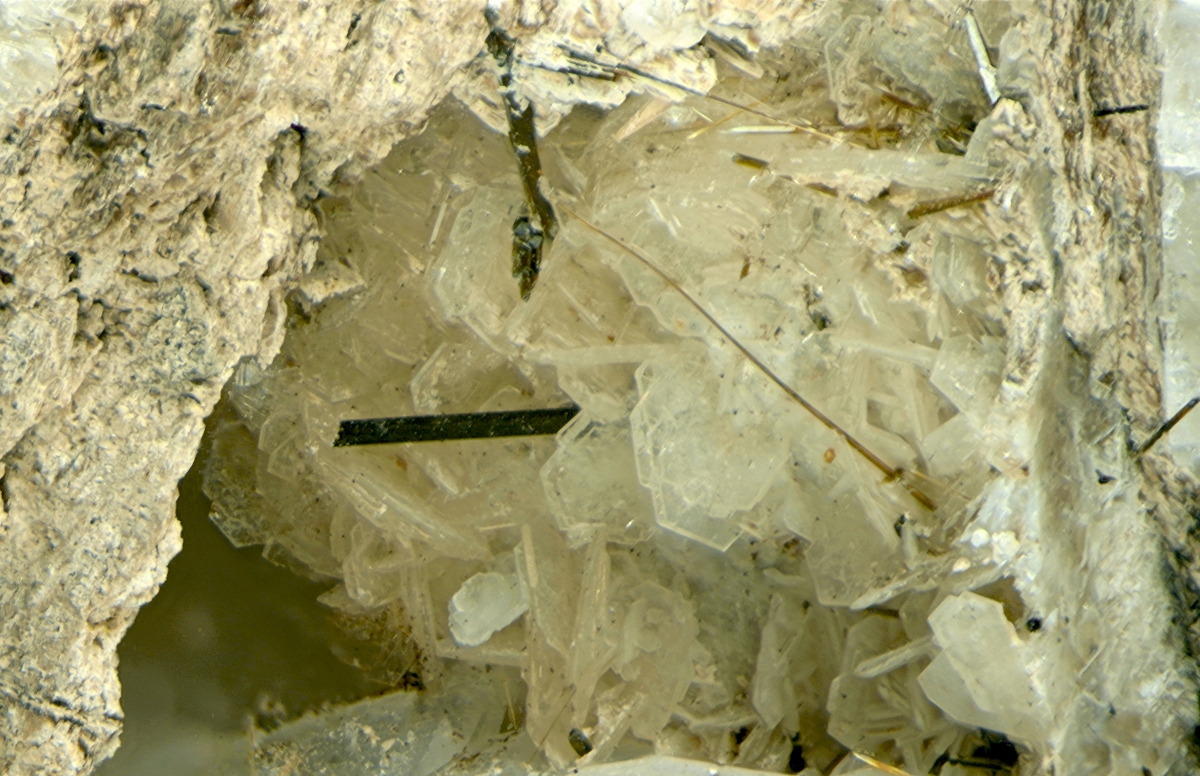This specimen features dozens of small crystals of catapleiite, many strung on aegirine like tiny butterflies, along with a couple of unusual black crystals of pyrochlore (group).
Perhaps the most interesting – but unidentified - mineral on the specimen consists of a large area of platy to grainy material that, several years ago, was tentatively identified (on another specimen) at Laurentian University as an (Na, Ca, K)(Nb,Ti) silicate with F, with ratios that would fit within the epistolite-murmanite series. (Subsequently “murmanite group” appears to have become “lomonosovite group”, the definition of which seems to be a muddle. Lomonosovite itself is listed as a member of the “epistolite group”!) In any case, the sample tested (less so the stuff on this specimen, which seems largely altered) does bear a visual resemblance to epistolite. I posted this as "epistolite" because other members of the group have not been reported from MSH - but bear in mind that the material looks altered. Epistolite is extremely rare in the pegmatites at MSH. (Not that it is common in the sodalite xenoliths.) Very, very, unusual. But ultimately probably very, very, frustrating - unless you have access to very sophisticated analytical techniques. Regardless of the “epistolite-murmanite” this is a very interesting - but large – “micro”.
The first pair of photos (FOV 4.6 x 6.9 mm). Shows one of the most attractive groups of catapleiite “butterflies”. The greatest “wingspan” is ca 0.9 mm.
The second pair of photos (FOV 6.6 x 3.8 mm) shows another, similar, cavity with somewhat larger individual crystals to 1.0 mm. There are several other such aggregates on the specimen.
Opaque white catapleiite is rather unusual, but the crystals grade to more typical looking catapleiite on other parts of the specimen. One such area is shown in the next pair of photos (FOV 6.3 x 4.1 mm). Here the crystals are as large as 1.4 mm, but mostly still < 1mm.
The next pair of photos (FOV 3.6 x 2.1 mm), shows one of the black “pyrochlore” crystals, ca 0.55 mm on edge, which is actually fairly large for MSH. The two species of “pyrochlore” validated at MSH are fluorcalciopyrochlore and fluornatropyrochlore. This material was not analyzed. Because of the dark color, I would not be surprised if it is Th enriched – but that’s just a guess. The isolated catapleiite crystal in the upper left corner is 0.6 mm in diameter. The pointy sticks are aegirine.
The last close-up photo (FOV 6.6 x 4.6 mm) shows a small section of the platy/grainy “epistolite-murmanite”. The typical looking catapleiite crystal in the upper right corner is again 0.6 mm in diameter. The platy appearance of the “epistolite-murmanite” is more apparent in the full-view photo. (The color is more accurate as well.) All those arrows point to (some) of the catapleiite and pyrochlore.
Note: I have included a qualitative EDS scan for the "epistolite-murmaniter" from this find that was more completely analyzed at Laurentian University.
Single item shipping weight (no case) is 6.1 oz (173 g). For shipments outside the USA, up to a total weight < 8 oz (225g), this can be combined with items from this or other auctions for the same postage.
Within the USA, postage for total weights up to 13 oz ranges from $4.50 to $6.50 (including packing etc) regardless of destination. Above 13 oz, I will use “own box” Priority Mail. The rate, including packing, varies by destination from $7.25 to $9.50.

































